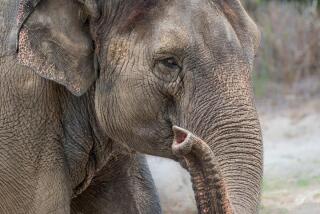Greg du Toit captures magic of elephants, other creatures with camera
JOHANNESBURG, South Africa -- Wildlife photographer Greg du Toit has stared down lionesses, been charged by hippos and been chased by an angry bull elephant. He’s been trampled by a buffalo (“But it didn’t gore me”) and had close encounters with crocodiles (“But I never got bitten”).
Waiting sometimes for months submerged in shallow water for the perfect shot, the South African has been eaten alive by tsetse flies and mosquitoes. He’s had malaria twice and a much nastier tropical disease called bilharzia twice.
Du Toit flew home Thursday after being named Wildlife Photographer of the Year in a competition held by the National History Museum in London and BBC Worldwide, beating nearly 43,000 other entries from 96 countries, including the biggest names in wildlife photography.
There are times when his job lacks its reputed adventure and glamour: like returning week after week to spend all day in a dug-out hide stinking of baboon droppings, in 100-degree-plus heat, waiting for animals to appear.
“I feel like I was born too late,” he said in a telephone interview after returning to Johannesburg. “My whole life I have been on a journey looking for the real Africa,” he added, describing his eternal search for those small hidden pockets of undisturbed Africa, the way he imagines the continent must once have been.
Du Toit trained as a safari guide, not as a photographer. He believes his understanding of animal behavior is what helps him get in close to animals for the best shots.
At first, his obsession was with photographing his wildlife heroes full-frame. But he grew as an artist and began to focus on capturing one perfect moment. Later still, he zoomed out and worked on portraying the grandeur of an African animal in a wide, awesome landscape.
“You can communicate more of the sense of wonder and awe that I feel for the land,” he said. His book “Awe,” to be released Saturday, portrays all three stages of his career.
Du Toit switched from being a safari guide to a photographer after a 22-month stint living in southern Tanzania, where a young elephant adopted him and his wife. Du Toit built the young bull a mudhole and often had to repair the pipes the elephant tore out.
“Once he saw me fixing the pipe and he didn’t like it, because he was possessive of the mud wallow. He came charging out of the bush toward me. I had him right behind me as I dove into the door of our house and he slammed on anchors.”
After nearly being killed by the bull elephant, Du Toit decided he had lived the hard life long enough and had enough photographs to move back to South Africa in 2008 to become a professional wildlife photographer. He still travels about half the time.
One of his most dangerous episodes happened toward the end of a 16-month stint camped at a water hole in southern Kenya. He had one objective: a shot of wild lions drinking at the spot.
His hideout didn’t work well, so for several months he tried a tent on a small island in the water hole. That didn’t work either. He ended up submerged in the water, with only his camera, head and hands visible. For months he photographed geese, waterbucks and zebras, until one Friday evening, when two lionesses padded up and started drinking, just five yards from where he was submerged.
Du Toit suddenly realized he could be prey. Adrenalin surged. His hands started shaking uncontrollably, making it impossible to take a photograph.
“Closing my eyes and lowering my head, I became conscious of the irony unfolding before me. Here I was, after months of patience and preparation, with my ultimate shot just meters away and no way to capture the image?” he wrote in his blog, describing the scene.
When he did shoot their photographs, they looked at him quizzically, as though trying to decide what he was. But it was getting dark and once the sun had gone down, he wouldn’t know where the cats were. He knew he had to get back to his car.
The difficult moment came as he had to extract himself from the water hole while they continued to stare.
“Every time I moved, the predator duo would prick their ears and fix their gaze on my protruding head.” He moved slowly to the opposite shore, flipped over, stood up and ran.
His winning photo was of a young elephant calf running around a water hole in Tuli Block, Botswana. For years, Du Toit had been trying to find a way to convey the special energy he always picked up from elephants in the wild.
“It’s almost like a cognitive energy. You know that the animal is highly intelligent. It knows that you’re there and might be having thoughts about you. But it’s very hard to translate that into a photograph,” he said. When he tried photographing them, he was always frustrated. They came out big, gray and static.
In his Tuli Block shot, he used a slow shutter speed “which allowed all that energy to fly into the camera” and waited, soaking up the peaceful energy of a group of elephants. Then it happened.
“This little baby elephant was happy to race past my camera just two feet from my lens.”
It was a moment he’d waited for all his life.
ALSO:
Slavery still haunts Africa, where millions remain captive
Britain to accept public input in debate on U.S. and domestic spying
Russian astronomers say asteroid might collide with Earth -- in 2032
Twitter: @latimesdixon
More to Read
Start your day right
Sign up for Essential California for news, features and recommendations from the L.A. Times and beyond in your inbox six days a week.
You may occasionally receive promotional content from the Los Angeles Times.





